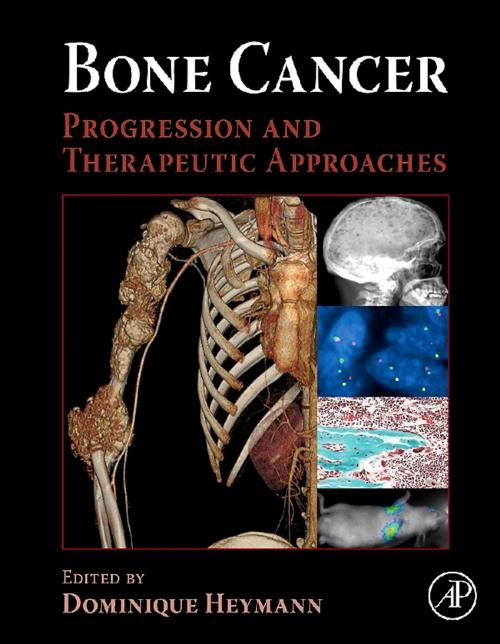Bone Cancer
Progression and Therapeutic Approaches
Nonfiction, Health & Well Being, Medical, Specialties, Internal Medicine, Endocrinology & Metabolism, Orthopedics| Author: | Elsevier Science | ISBN: | 9780080953885 |
| Publisher: | Elsevier Science | Publication: | August 20, 2009 |
| Imprint: | Academic Press | Language: | English |
| Author: | Elsevier Science |
| ISBN: | 9780080953885 |
| Publisher: | Elsevier Science |
| Publication: | August 20, 2009 |
| Imprint: | Academic Press |
| Language: | English |
The epidemiological and clinical importance of bone metastasis has long been recognized, but the past decade has seen an explosion in the fields of bone biology and bone cancer research. This period of time has been marked by a number of key discoveries that have led to the opening up of entirely new areas for investigation as well as new therapies which combine surgery and biological therapeutic approaches.
Bone is a common site of cancer metastases - cancer cells commonly develop in bone and spread to other organ systems through the bloodstream. For example, the incidence of bone metastases in breast and prostate cancers is 70%, whereas it is only 30 to 40% in metastatic lung cancer. In clinical terms, bone metastases have substantial negative effects on a patient's quality of life and are a main cause of patient mortality.
Given the global prevalence of breast and prostate cancers, knowledge of bone biology has become essential for the medical and cancer research communities. This book provides, all in one resource, the most recent data on bone cancer development (cellular and molecular mechanisms), genomic and proteomic analyses, clinical analyses (histopathology, imaging, pain monitoring), as well as new therapeutic approaches and clinical trials for primary bone tumors and bone metastases.
-
Feature
-
Presents a comprehensive, translational source for all aspects of bone cancer in one reference work
-
Bone cancer experts (from all areas of research and practice) take readers from the bench research (cellular and molecular mechanism), through genomic and proteomic analysis, all the way to clinical analysis (histopathology and imaging) and new therapeutic approaches.
-
Clear presentation by bone biologists of the cellular and molecular mechanisms underlying bone tumors and bone cancer metastasis as well as the genomic and proteomic assays used in detecting cancer within given organ systems
-
Clear presentation by oncologists and radiologists of how histopathology, imaging, and pain monitoring can lead to new therapeutic approaches
-
Benefit
-
Saves researchers and clinicians time in quickly accessing the very latest details on a broad range of bone cancer issues, as opposed to searching through thousands of journal articles.
-
Provides a common language for cancer researchers, bone biologists, oncologists, and radiologists to discuss bone tumors and how bone cancer metastases affects each major organ system
-
Correct diagnosis (and therefore correct treatment) of cancer depends on a strong understanding of the molecular basis for the disease – both oncologists and radiologists will benefit
-
Bone biologists will gain insight into how clinical observations and practices can feed back into the research cycle and will, therefore, be able to develop more targeted genomic and proteomic assays
The epidemiological and clinical importance of bone metastasis has long been recognized, but the past decade has seen an explosion in the fields of bone biology and bone cancer research. This period of time has been marked by a number of key discoveries that have led to the opening up of entirely new areas for investigation as well as new therapies which combine surgery and biological therapeutic approaches.
Bone is a common site of cancer metastases - cancer cells commonly develop in bone and spread to other organ systems through the bloodstream. For example, the incidence of bone metastases in breast and prostate cancers is 70%, whereas it is only 30 to 40% in metastatic lung cancer. In clinical terms, bone metastases have substantial negative effects on a patient's quality of life and are a main cause of patient mortality.
Given the global prevalence of breast and prostate cancers, knowledge of bone biology has become essential for the medical and cancer research communities. This book provides, all in one resource, the most recent data on bone cancer development (cellular and molecular mechanisms), genomic and proteomic analyses, clinical analyses (histopathology, imaging, pain monitoring), as well as new therapeutic approaches and clinical trials for primary bone tumors and bone metastases.
-
Feature
-
Presents a comprehensive, translational source for all aspects of bone cancer in one reference work
-
Bone cancer experts (from all areas of research and practice) take readers from the bench research (cellular and molecular mechanism), through genomic and proteomic analysis, all the way to clinical analysis (histopathology and imaging) and new therapeutic approaches.
-
Clear presentation by bone biologists of the cellular and molecular mechanisms underlying bone tumors and bone cancer metastasis as well as the genomic and proteomic assays used in detecting cancer within given organ systems
-
Clear presentation by oncologists and radiologists of how histopathology, imaging, and pain monitoring can lead to new therapeutic approaches
-
Benefit
-
Saves researchers and clinicians time in quickly accessing the very latest details on a broad range of bone cancer issues, as opposed to searching through thousands of journal articles.
-
Provides a common language for cancer researchers, bone biologists, oncologists, and radiologists to discuss bone tumors and how bone cancer metastases affects each major organ system
-
Correct diagnosis (and therefore correct treatment) of cancer depends on a strong understanding of the molecular basis for the disease – both oncologists and radiologists will benefit
-
Bone biologists will gain insight into how clinical observations and practices can feed back into the research cycle and will, therefore, be able to develop more targeted genomic and proteomic assays















